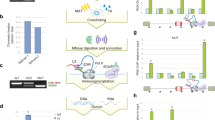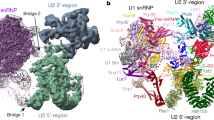Abstract
In the nucleus of higher eukaryotes, maturation of mRNA precursors involves an orderly sequence of transcription-coupled interdependent steps. Transcription is well known to influence splicing, but how splicing may affect transcription remains unclear. Here we show that a splicing mutation that prevents recruitment of spliceosomal snRNPs to nascent transcripts causes co-transcriptional retention of unprocessed RNAs that remain associated with polymerases stalled predominantly at the 3′ end of the gene. In contrast, treatment with spliceostatin A, which allows early spliceosome formation but destabilizes subsequent assembly of the catalytic complex, abolishes 3′ end pausing of polymerases and induces leakage of unspliced transcripts to the nucleoplasm. Taken together, the data suggest that recruitment of splicing factors and correct assembly of the spliceosome are coupled to transcription termination, and this might ensure a proofreading mechanism that slows down release of unprocessed transcripts from the transcription site.
This is a preview of subscription content, access via your institution
Access options
Subscribe to this journal
Receive 12 print issues and online access
$189.00 per year
only $15.75 per issue
Buy this article
- Purchase on Springer Link
- Instant access to full article PDF
Prices may be subject to local taxes which are calculated during checkout








Similar content being viewed by others
References
McCracken, S. et al. The C-terminal domain of RNA polymerase II couples mRNA processing to transcription. Nature 385, 357–361 (1997).
Moore, M.J. & Proudfoot, N.J. Pre-mRNA processing reaches back to transcription and ahead to translation. Cell 136, 688–700 (2009).
Fuda, N.J., Ardehali, M.B. & Lis, J.T. Defining mechanisms that regulate RNA polymerase II transcription in vivo. Nature 461, 186–192 (2009).
de Almeida, S.F. & Carmo-Fonseca, M. The CTD role in cotranscriptional RNA processing and surveillance. FEBS Lett. 582, 1971–1976 (2008).
Sims, R.J. III, Belotserkovskaya, R. & Reinberg, D. Elongation by RNA polymerase II: the short and long of it. Genes Dev. 18, 2437–2468 (2004).
Buratowski, S. Progression through the RNA polymerase II CTD cycle. Mol. Cell 36, 541–546 (2009).
Brinster, R.L., Allen, J.M., Behringer, R.R., Gelinas, R.E. & Palmiter, R.D. Introns increase transcriptional efficiency in transgenic mice. Proc. Natl. Acad. Sci. USA 85, 836–840 (1988).
Lu, S. & Cullen, B.R. Analysis of the stimulatory effect of splicing on mRNA production and utilization in mammalian cells. RNA 9, 618–630 (2003).
Fong, Y.W. & Zhou, Q. Stimulatory effect of splicing factors on transcriptional elongation. Nature 414, 929–933 (2001).
Kameoka, S., Duque, P. & Konarska, M.M. p54(nrb) associates with the 5′ splice site within large transcription/splicing complexes. EMBO J. 23, 1782–1791 (2004).
Furger, A., O'Sullivan, J.M., Binnie, A., Lee, B.A. & Proudfoot, N.J. Promoter proximal splice sites enhance transcription. Genes Dev. 16, 2792–2799 (2002).
Brès, V., Gomes, N., Pickle, L. & Jones, K.A. A human splicing factor, SKIP, associates with P-TEFb and enhances transcription elongation by HIV-1 Tat. Genes Dev. 19, 1211–1226 (2005).
Zorio, D.A. & Bentley, D.L. The link between mRNA processing and transcription: communication works both ways. Exp. Cell Res. 296, 91–97 (2004).
Lin, S., Coutinho-Mansfield, G., Wang, D., Pandit, S. & Fu, X.D. The splicing factor SC35 has an active role in transcriptional elongation. Nat. Struct. Mol. Biol. 15, 819–826 (2008).
Lowary, P.T. & Uhlenbeck, O.C. An RNA mutation that increases the affinity of an RNA-protein interaction. Nucleic Acids Res. 15, 10483–10493 (1987).
Boireau, S. et al. The transcriptional cycle of HIV-1 in real-time and live cells. J. Cell Biol. 179, 291–304 (2007).
Chapman, R.D., Conrad, M. & Eick, D. Role of the mammalian RNA polymerase II C-terminal domain (CTD) nonconsensus repeats in CTD stability and cell proliferation. Mol. Cell. Biol. 25, 7665–7674 (2005).
Bushnell, D.A., Cramer, P. & Kornberg, R.D. Structural basis of transcription: alpha-amanitin-RNA polymerase II cocrystal at 2.8 Å resolution. Proc. Natl. Acad. Sci. USA 99, 1218–1222 (2002).
Nguyen, V.T. et al. In vivo degradation of RNA polymerase II largest subunit triggered by alpha-amanitin. Nucleic Acids Res. 24, 2924–2929 (1996).
Darzacq, X. et al. In vivo dynamics of RNA polymerase II transcription. Nat. Struct. Mol. Biol. 14, 796–806 (2007).
Yunger, S., Rosenfeld, L., Garini, Y. & Shav-Tal, Y. Single-allele analysis of transcription kinetics in living mammalian cells. Nat. Methods 7, 631–633 (2010).
Dye, M.J. & Proudfoot, N.J. Terminal exon definition occurs cotranscriptionally and promotes termination of RNA polymerase II. Mol. Cell 3, 371–378 (1999).
Dye, M.J. & Proudfoot, N.J. Multiple transcript cleavage precedes polymerase release in termination by RNA polymerase II. Cell 105, 669–681 (2001).
Gromak, N., West, S. & Proudfoot, N.J. Pause sites promote transcriptional termination of mammalian RNA polymerase II. Mol. Cell. Biol. 26, 3986–3996 (2006).
Listerman, I., Sapra, A.K. & Neugebauer, K.M. Cotranscriptional coupling of splicing factor recruitment and precursor messenger RNA splicing in mammalian cells. Nat. Struct. Mol. Biol. 13, 815–822 (2006).
Berget, S.M. Exon recognition in vertebrate splicing. J. Biol. Chem. 270, 2411–2414 (1995).
Custódio, N. et al. Inefficient processing impairs release of RNA from the site of transcription. EMBO J. 18, 2855–2866 (1999).
de Almeida, S.F., Garcia-Sacristan, A., Custodio, N. & Carmo-Fonseca, M. A link between nuclear RNA surveillance, the human exosome and RNA polymerase II transcriptional termination. Nucleic Acids Res. 38, 8015–8026 (2010).
Custódio, N. et al. In vivo recruitment of exon junction complex proteins to transcription sites in mammalian cell nuclei. RNA 10, 622–633 (2004).
Damgaard, C.K. et al. A 5′ splice site enhances the recruitment of basal transcription initiation factors in vivo. Mol. Cell 29, 271–278 (2008).
West, S. & Proudfoot, N.J. Transcriptional termination enhances protein expression in human cells. Mol. Cell 33, 354–364 (2009).
Kaida, D. et al. Spliceostatin A targets SF3b and inhibits both splicing and nuclear retention of pre-mRNA. Nat. Chem. Biol. 3, 576–583 (2007).
Roybal, G.A. & Jurica, M.S. Spliceostatin A inhibits spliceosome assembly subsequent to prespliceosome formation. Nucleic Acids Res. 38, 6664–6672 (2010).
Corrionero, A., Minana, B. & Valcarcel, J. Reduced fidelity of branch point recognition and alternative splicing induced by the anti-tumor drug spliceostatin A. Genes Dev. 25, 445–459 (2011).
Elbashir, S.M., Martinez, J., Patkaniowska, A., Lendeckel, W. & Tuschl, T. Functional anatomy of siRNAs for mediating efficient RNAi in Drosophila melanogaster embryo lysate. EMBO J. 20, 6877–6888 (2001).
Glover-Cutter, K., Kim, S., Espinosa, J. & Bentley, D.L. RNA polymerase II pauses and associates with pre-mRNA processing factors at both ends of genes. Nat. Struct. Mol. Biol. 15, 71–78 (2008).
Wahl, M.C., Will, C.L. & Luhrmann, R. The spliceosome: design principles of a dynamic RNP machine. Cell 136, 701–718 (2009).
Janicki, S.M. et al. From silencing to gene expression: real-time analysis in single cells. Cell 116, 683–698 (2004).
Carrillo Oesterreich, F., Preibisch, S. & Neugebauer, K.M. Global analysis of nascent RNA reveals transcriptional pausing in terminal exons. Mol. Cell 40, 571–581 (2010).
Alexander, R.D., Innocente, S.A., Barrass, J.D. & Beggs, J.D. Splicing-dependent RNA polymerase pausing in yeast. Mol. Cell 40, 582–593 (2010).
Niwa, M., Rose, S.D. & Berget, S.M. In vitro polyadenylation is stimulated by the presence of an upstream intron. Genes Dev. 4, 1552–1559 (1990).
Niwa, M. & Berget, S.M. Mutation of the AAUAAA polyadenylation signal depresses in vitro splicing of proximal but not distal introns. Genes Dev. 5, 2086–2095 (1991).
Brody, Y. et al. The in vivo kinetics of RNA polymerase II elongation during co-transcriptional splicing. PLoS Biol. 9, e1000573 (2011).
O'Keefe, R.T., Mayeda, A., Sadowski, C.L., Krainer, A.R. & Spector, D.L. Disruption of pre-mRNA splicing in vivo results in reorganization of splicing factors. J. Cell Biol. 124, 249–260 (1994).
Lykke-Andersen, J., Shu, M.D. & Steitz, J.A. Human Upf proteins target an mRNA for nonsense-mediated decay when bound downstream of a termination codon. Cell 103, 1121–1131 (2000).
Barsoum, J. Introduction of stable high-copy-number DNA into Chinese hamster ovary cells by electroporation. DNA Cell Biol. 9, 293–300 (1990).
Phair, R.D. & Misteli, T. High mobility of proteins in the mammalian cell nucleus. Nature 404, 604–609 (2000).
Pacheco, T.R., Moita, L.F., Gomes, A.Q., Hacohen, N. & Carmo-Fonseca, M. RNA interference knockdown of hU2AF35 impairs cell cycle progression and modulates alternative splicing of Cdc25 transcripts. Mol. Biol. Cell 17, 4187–4199 (2006).
Nelson, J.D., Denisenko, O., Sova, P. & Bomsztyk, K. Fast chromatin immunoprecipitation assay. Nucleic Acids Res. 34, e2 (2006).
Blencowe, B.J., Issner, R., Nickerson, J.A. & Sharp, P.A. A coactivator of pre-mRNA splicing. Genes Dev. 12, 996–1009 (1998).
Acknowledgements
We are grateful to R. Singer from Albert Einstein College of Medicine, E. Bertrand from the Institute of Molecular Genetics of Montpellier (IGMM) and Y. Shav-Tal from Bar-Ilan University for insightful discussions and technical advice. We also thank E. Bertrand (IGMM), J. Lykke-Andersen (University of California, San Diego), N. Gehring (Heidelberg University), R. Chapman (Helmholtz Institute Munich), B. Blencowe (University of Toronto) and M. Antoniou (King's College London) for kindly providing reagents. This work was supported by Fundação para a Ciência e Tecnologia (PTDC/BIA-BCM/101575/2008 to M.C.-F., SFRH/BPD/42523/2007 to J.R. and SFRH/BPD/34679/2007 to S.F.d.A.) and the European Commission (EURASNET, LSHG-CT-2005-518238 to M.C.-F.).
Author information
Authors and Affiliations
Contributions
S.B.M. and J.R. designed and conducted the experiments and analyzed the data. J.R. was responsible for the microscopy. T.C. and C.C. generated and characterized the cell lines. J.M.K. carried out ChIP experiments and S.F.d.A. designed, conducted and analyzed biochemical experiments. M.Y. synthesized SSA. M.C.-F. conceived and supervised the project. S.B.M., J.R. and M.C.-F. wrote the paper.
Corresponding author
Ethics declarations
Competing interests
The authors declare no competing financial interests.
Supplementary information
Supplementary Text and Figures
Supplementary Figures 1–6 and Supplementary Tables 1 and 2 (PDF 1303 kb)
Rights and permissions
About this article
Cite this article
Martins, S., Rino, J., Carvalho, T. et al. Spliceosome assembly is coupled to RNA polymerase II dynamics at the 3′ end of human genes. Nat Struct Mol Biol 18, 1115–1123 (2011). https://doi.org/10.1038/nsmb.2124
Received:
Accepted:
Published:
Issue Date:
DOI: https://doi.org/10.1038/nsmb.2124
This article is cited by
-
A role for heritable transcriptomic variation in maize adaptation to temperate environments
Genome Biology (2023)
-
Coordination of alternative splicing and alternative polyadenylation revealed by targeted long read sequencing
Nature Communications (2023)
-
Molecular basis of differential 3′ splice site sensitivity to anti-tumor drugs targeting U2 snRNP
Nature Communications (2017)
-
EWS and FUS bind a subset of transcribed genes encoding proteins enriched in RNA regulatory functions
BMC Genomics (2015)
-
Coupling mRNA processing with transcription in time and space
Nature Reviews Genetics (2014)



